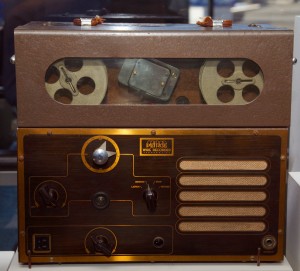
A Peirce 55-B dictation wire recorder from 1945. Courtesy of Stanford University Libraries. Source: Wikipedia.
A good portion of our nation’s heritage has been immortalized in sound recordings. From the late 19th century to the present, sound recordings have been used to capture music, speeches and historic events, the oral histories of people who have lived through important events in our nation’s history.
As with many electronic and mechanical recordings, however, this vast heritage is in danger. In an effort to save what we can of these timeless recordings, the Library of Congress has put together a blueprint in the form of a National Preservation Plan. This plan is the result of nearly a decade of work that was mandated by Congress as part of the National Recording Preservation Act of 2000.
As the Library of Congress puts in in their press release:
Experts estimate that more than half of the titles recorded on cylinder records—the dominant format used by the U.S. recording industry during its first 23 years—have not survived. The archive of one of radio’s leading networks is lost. A fire at the storage facility of a principal record company ruined an unknown number of master recordings of both owned and leased materials. The whereabouts of a wire recording made by the crew members of the Enola Gay from inside the plane as the atom bomb was dropped on Hiroshima are unknown. Many key recordings made by George Gershwin no longer survive. Recordings by Frank Sinatra, Judy Garland, and other top recording artists have been lost. Personal collections belonging to recording artists were destroyed in Hurricanes Katrina and Sandy.
The National Preservation Plan for sound recordings is available as a PDF file. In it, multiple recommendations are made, including:
- Create a publicly accessible national directory of institutional, corporate and private recorded-sound collections and an authoritative national discography that details the production of recordings and the location of preservation copies in public institutions;
- Develop a coordinated national collections policy for sound recordings, including a strategy to collect, catalog and preserve locally produced recordings, radio broadcast content and neglected and emerging audio formats and genres;
- Establish university-based degree programs in audio archiving and preservation and continuing education programs for practicing audio engineers, archivists, curators and librarians;
- Construct environmentally controlled storage facilities to provide optimal conditions for long-term preservation;
- Establish an Audio-Preservation Resource Directory website to house a basic audio-preservation handbook, collections appraisal guidelines, metadata standards and other resources and best practices;
- Establish best practices for creating and preserving born-digital audio files;
- Apply federal copyright law to sound recordings created before February 15, 1972;
- Develop a basic licensing agreement to enable on-demand secure streaming by libraries and archives of out-of-print recordings;
- Organize an advisory committee of industry executives and heads of archives to address recorded sound preservation and access issues that require public-private cooperation for resolution.
